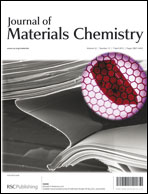In this paper for the first time we present a systematic study of the influence of hydrophobicity of Pd(II) compounds, (CH3CN)2PdCl2, (PhCN)2PdCl2, (Sty)(CH3CN)PdCl2, and (StyPdCl2)2, on nanoparticle (NP) formation in the pores of hydrophobic micro/mesoporous hypercrosslinked polystyrene (HPS). The morphology and composition of HPS–Pd nanocomposites were studied using transmission electron microscopy, X-ray fluorescence measurements, X-ray photoelectron spectroscopy, and liquid nitrogen physisorption. The size and location of Pd compound NPs were found to depend on hydrophobicity of the Pd(II) environment. Catalytic testing of these nanocomposites in D-glucose oxidation was carried out to illustrate the influence of nanoparticle size and environment on catalytic activity. The highest catalytic activity was achieved for (Sty)(CH3CN)PdCl2, forming smallest NPs and allowing an optimal hydrophobicity–hydrophilicity balance with HPS.
You have access to this article
 Please wait while we load your content...
Something went wrong. Try again?
Please wait while we load your content...
Something went wrong. Try again?


 Please wait while we load your content...
Please wait while we load your content...